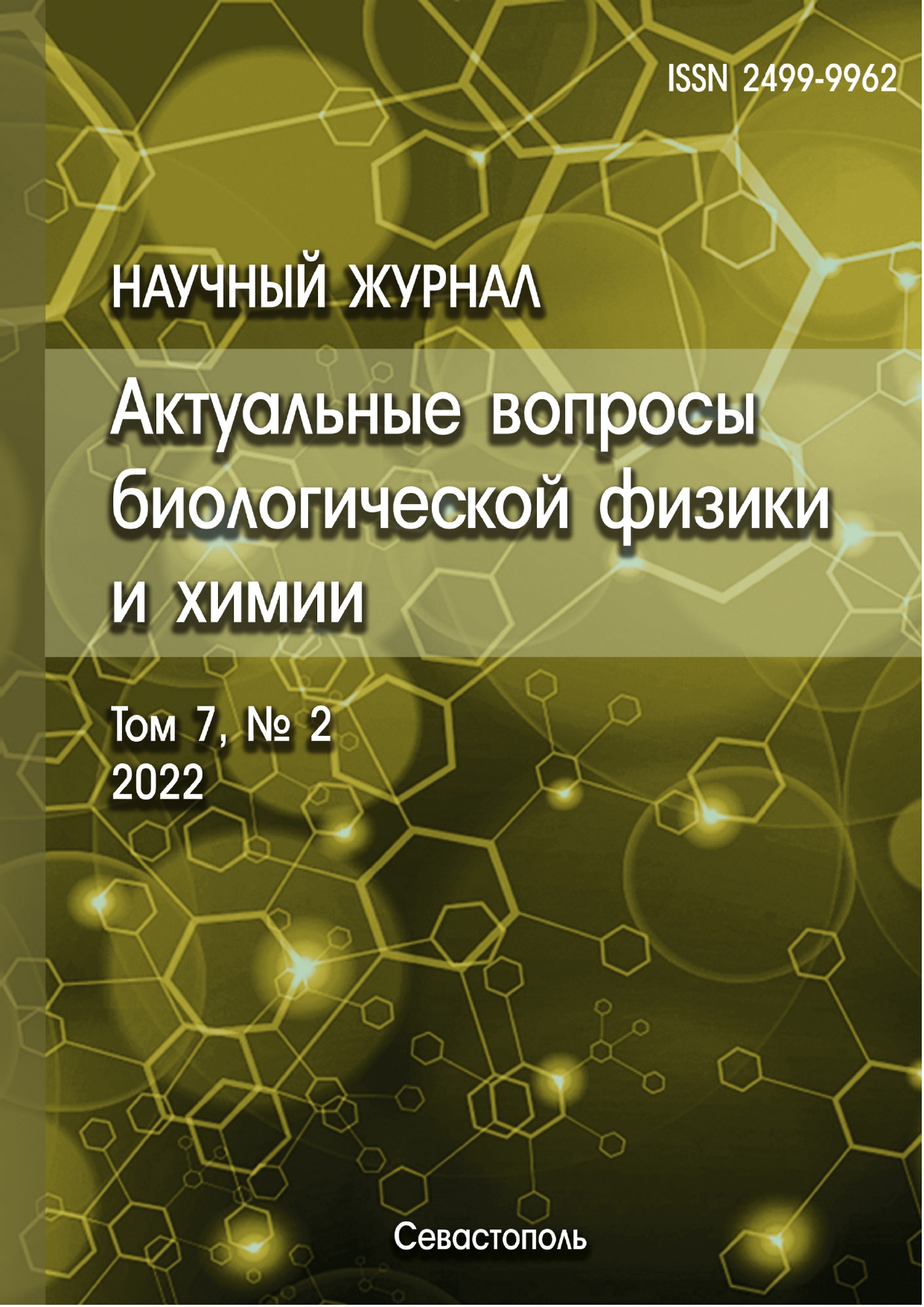Баку, Азербайджан
Баку, Азербайджан
Баку, Азербайджан
Nanoparticles are extensively used in various areas of industry. Among different nanoparticles, protein nanoparticles complexed with a wide range of drugs have a great potential for biomedical applications. Silk fibroin exhibits good biocompatibility properties and, therefore, is a good raw material for a wide variety of applications. In this study, structure and hydrophobic patch formation were studied in nanoparticles fabricated from silk fibroin. Far-UV circular dichroism spectroscopy and birefringence observed in a polarized microscope with Congo red staining indicate that fibroin nanoparticles are composed of small amyloid domains. Steady-state and time-resolved fluorescence of ANS revealed two hydrophobic patch formations. Decay-associated spectra of ANS bound to these patches show two species with lifetimes of about 4.2 ns and 14.8 ns. Dissociation constants for ANS complex formation for these patches are 8.3±0.4 M and 5.9±0.3 M, respectively. Acrylamide fluorescence quenching shows that solvent accessibility to native Trp residues is significantly decreased during fibroin nanoparticle formation. Data indicate that nanoparticles fabricated from fibroin are a good candidate for drug delivery applications.
protein nanoparticles, steady-state and time-resolved fluorescence, ANS fluorescence, hydrophobic patches
1. Hong S., Choi D.W., Kim H.N., Park C.G., Lee W., Park H.H. Protein-based nanoparticles as drug delivery systems. Pharmaceutics, 2020, vol. 12, no. 7, pp. 1-28. DOI: https://doi.org/10.3390/pharmaceutics12070604; EDN: https://elibrary.ru/EVJNXP
2. Hawkins M.J., Soon-Shiong P., Desai N. Protein nanoparticles as drug carriers in clinical medicine. Adv. Drug Deliv. Rev., 2008., vol. 60, no. 8, pp. 876-885. DOI: https://doi.org/10.1016/j.addr.2007.08.044; EDN: https://elibrary.ru/MLQSFH
3. Weber C., Coester C., Kreuter J., Langer K. Desolvation process and surface characterisation of protein nanoparticles. Int. J. Pharm., 2000, vol. 194, no. 1, pp. 91-102. DOI: https://doi.org/10.1016/S0378-5173(99)00370-1; EDN: https://elibrary.ru/KKMQSX
4. Shao Z., Vollrath F. Surprising strength of silkworm silk. Nature, 2002, vol. 418, no. 6899, p. 741.
5. Suzuki Y., Yamazaki T., Aoki A., Shindo H., Asakura T. NMR study of the structures of repeated sequences, GAGXGA (X = S, Y, V), in bombyx mori liquid silk. Biomacromolecules, 2014, vol. 15, no. 1, pp. 104-112.
6. Gasymov O.K., Mammedzade A.M., Bakhishova M.J., Guliyeva A.J., Ragona L., Molinari H. Sodium fusidate prevents protein aggregation of silk fibroin and offers new perspectives for human lens material disaggregation. Biophys. Chem., 2021, vol. 279, p. 106680.
7. Zare-Zardini H., Vojdani Nejad Yazdi S., Zandian A., Zare F., Miresmaeili S.M., Dehghan-Manshadi M., Fesahat F. Synthesis, characterization, and biological evaluation of doxorubicin containing silk fibroin micro- and nanoparticles. J. Indian Chem. Soc., Elsevier Ltd, 2021, vol. 98, no. 10, p. 100161.
8. Giannelli M., Guerrini A., Ballestri M., Posati T., Aluigi A., Zamboni R., Sotgiu G. Bioactive Keratin and Fibroin Nanoparticles: An Overview of Their Preparation Strategies. Nanomaterials, 2022, vol. 12, no. 9. DOI: https://doi.org/10.3390/nano12091406; EDN: https://elibrary.ru/MCRSIX
9. Rockwood D.N., Preda R.C., Yucel T., Wang X., Lovett M.L., Kaplan D.L. Materials fabrication from Bombyx mori silk fibroin. Nat Protoc., 2011, vol. 6, no. 10, pp. 1612-1631.
10. Ragona L., Gasymov O., Guliyeva A.J., Aslanov R.B., Zanzoni S., Botta C., Molinari H. Rhodamine binds to silk fibroin and inhibits its self-aggregation. Biochim. Biophys. Acta, Proteins Proteomics, 2018, vol. 1866, no. 5-6, pp. 661-667.
11. Zhang Y.-Q. Preparation of Silk Fibroin Nanoparticles and Enzyme-Entrapped Silk Fibroin Nanoparticles. Bio-Protocol., 2018, vol. 8, no. 24, pp. 20-24.
12. Whitmore L., Wallace B.A. DICHROWEB, an online server for protein secondary structure analyses from circular dichroism spectroscopic data. Nucleic Acids Res., 2004, vol. 32, no. Web Server, pp. W668-W673.
13. Whitmore L., Wallace B.A. Protein secondary structure analyses from circular dichroism spectroscopy: Methods and reference databases. Biopolymers, 2008, vol. 89, no. 5, pp. 392-400.
14. Compton L.A., Johnson W.C. Analysis of protein circular dichroism spectra for secondary structure using a simple matrix multiplication. Anal. Biochem., 1986, vol. 155, no. 1, pp. 155-167.
15. Manavalan P., Johnson W.C. Variable selection method improves the prediction of protein secondary structure from circular dichroism spectra. Anal. Biochem., 1987, vol. 167, no. 1, pp. 76-85.
16. Antimonova O.I., Grudinina N.A., Egorov V.V., Polyakov D.S., Il’in V.V., Shavlovskii M.M. Interaction of the dye Congo red with fibrils of lysozyme, beta2-microglobulin, and transthyretin. Cell tissue biol., 2016, vol. 10, no. 6, pp. 468-475. DOI: https://doi.org/10.1134/S1990519X1606002X; EDN: https://elibrary.ru/YUXGFB
17. Gasymov O.K., Abduragimov A.R., Glasgow B.J. Evidence for internal and external binding sites on human tear lipocalin. Arch. Biochem. Biophys., 2007, vol. 468, no. 1, pp. 15-21.
18. Howie A.J., Brewer D.B. Optical properties of amyloid stained by Congo red: History and mechanisms. Micron., 2009, vol. 40, no. 3, pp. 285-301. DOI: https://doi.org/10.1016/j.micron.2008.10.002; EDN: https://elibrary.ru/MFVWJZ
19. Burstein E., Vedenkina N., Ivkova M. Tryptophan Residues in Protein Molecules. Photochem. Photobiol., 1973, vol. 18, pp. 263-279.
20. Gasymov O.K., Abduragimov A.R., Yusifov T.N., Glasgow B.J. Site-Directed Tryptophan Fluorescence Reveals the Solution Structure of Tear Lipocalin: Evidence for Features That Confer Promiscuity in Ligand Binding. Biochemistry, 2001, vol. 40, no. 49, pp. 14754-14762.
21. Gasymov O.K., Glasgow B.J. ANS fluorescence: Potential to augment the identification of the external binding sites of proteins. Biochim. Biophys. Acta, 2007, vol. 1774, no, 3, pp. 403-411.
22. Guliyeva A.J., Gasymov O.K. ANS fluorescence: Potential to discriminate hydrophobic sites of proteins in solid states. Biochem. Biophys. Reports, 2020, vol. 24, no. August, p. 100843.










